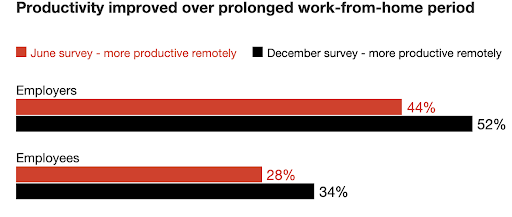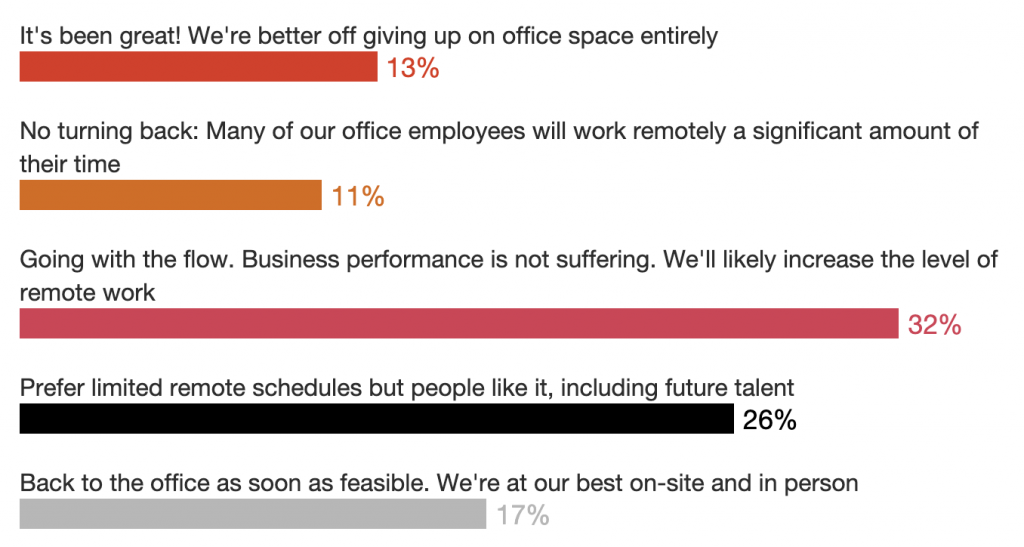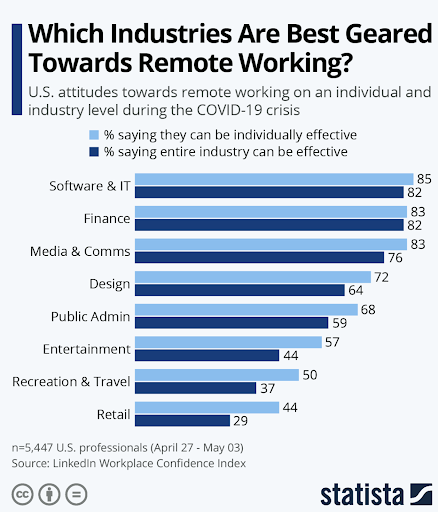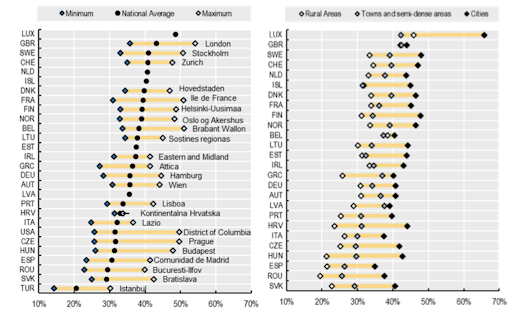
13 Apr The Future of Remote Work
What will work look like after the pandemic? Remote work is here to stay.
In 2020 the job market saw an historic shift due to the Covid-19 pandemic. With almost every field and sector affected, many businesses were forced to transition to remote work and virtual methods of operation. What was once considered a job perk has now become the norm for most organizations around the world, and this trend is only expected to continue. According to a survey from Enterprise Technology Research (ETR) the percentage of workers permanently working from home is expected to double throughout 2021.
Global Workplace Analytics (2021) estimates that approximately 56% of the U.S. workforce holds a job that is compatible with remote work. Before the onset of the COVID-19 pandemic only about 17% of employees in the U.S. worked from home 5 days per week, and throughout the pandemic this number increased to over 44% (Miltz, 2021). However, many people wonder what remote work will look like after the pandemic ends and life begins to return to ‘normal’.
Despite the opportunity to return to an in-office work setting, many business owners and employees have come to recognize the benefits of remote work and plan to maintain current working conditions even after the current COVID pandemic is over. In fact, according to a survey conducted by Gartner and PwC, 82% of company leaders, who are currently allowing remote work, plan to allow employees to work remotely after the pandemic ends and 78% of CEOs agree that remote collaboration is here to stay. Additionally, Kate Lister, president of Global Workplace Analytics, has been conducting large scale research on remote work trends for more than a decade. She predicts that the recent pandemic will be a tipping point for remote work programs, forecasting that an estimated 25M to 30M U.S. employees will regularly work from home within the next two years. Additionally, she estimates that work-from-home initiatives could save U.S. employers over $500 billion dollars per year.
Businesses see the value of allowing employees to work from home, not only for employee wellbeing (rating 4 points higher on the Workforce Happiness Index than their in-office counterparts) but also for the aforementioned economic benefits. A recent survey, conducted by Global Workplace Analytics, determined that an estimated $11k (per half-time remote worker) is being saved annually by businesses that allow their employees to work from home. This is due to a combination of reduced turnover, absenteeism, real estate costs, and increased productivity (Analytics, 2021). In fact, according to data collected from the PwC remote work survey (2021) many employers and employees reported significantly increased productivity after working from home for prolonged periods. In the December 2020 PwC survey 34% of employee respondents said that they are more productive now than they were before the pandemic (compared to 28% six months earlier). While 52% of executives claimed that employee productivity had improved, on average, since pre-pandemic times (compared to 44% who said the same six months earlier) (PwC, 2021).
(PwC US Remote Work Survey, 2021)

Additionally, the PwC survey found that the majority of executives had positive opinions about remote work throughout 2020, with only 17% of organizational leaders planning to return to an ‘in-office’ work setting.
These leaders responded to the following question: “Which of the following statements best describes how you feel about remote work at your company?”

(PwC US Remote Work Survey, 2021)
Despite the promising data, it is clear that remote work is not possible for all employees across every industry, which is why it is important for us to evaluate the organizations and business sectors that are currently offering remote work and the demographics of their employees. This will allow us to have a more comprehensive understanding of the expected trajectory of remote work over the next few years. In a survey conducted by Statista (2020), over 5,000 working professionals across several industries were asked how effective they thought the industry that they were working in could be with the majority of employees working remotely. The data showed that the IT, finance, and media industries are far more likely than the retail or travel industries to be successfully geared towards remote work, with the design, public administration, and entertainment industries falling somewhere between the two ends of the spectrum.

(Statista, 2020)
Additionally, according to Global Workplace Analytics’ special analysis of ACS data, larger companies are more likely than smaller companies to offer remote work options, full-time workers are nearly four times more likely than part-time workers to be able to work from home, and non-union workers are twice as likely to have access to remote work options than union workers. Additionally, in the United States, organizations based in New England and the Mid-Atlantic are more likely than organizations in other regions to offer remote work to their employees, with international averages represented in the chart below.

(Özgüzel, Veneri, Ahrend 2020)
According to Global Workplace Analytics’ special analysis of ACS data, the employees of these organizations are typically college-educated, over the age of 35, work at organizations with over 100 employees, and earn an annual salary of $55,000 or more. Additionally, 75% of the employees who work from home earn over $65,000 per year, which places them in the upper 80th percentile of all U.S. employees (home or office-based) (Analytics, 2021).
Despite the fact that remote work is not possible or ideal for every industry or employee, it is clear why so many organizations are looking to maintain and/or transition their employees to remote work. Erik Bradley, chief engagement strategist at ETR, confirms this point by stating that “the productivity metric is proving that remote work is working […] we all thought that there would be some increase in permanent remote work, but we didn’t expect that to double from pre-pandemic levels.” Whether it’s for increased employee productivity, employee job satisfaction, or simply for the economic benefits, it is apparent that remote work is here to stay.
References:
Analytics, G. W. (n.d.). Work-at-Home After Covid-19—Our Forecast. Global Workplace Analytics. Retrieved April 22, 2021, from https://globalworkplaceanalytics.com/work-at-home-after-covid-19-our-forecast
Gartner Survey Reveals 82% of Company Leaders Plan to Allow Employees to Work Remotely Some of the Time. (n.d.). Gartner. Retrieved April 22, 2021, from https://www.gartner.com/en/newsroom/press-releases/2020-07-14-gartner-survey-reveals-82-percent-of-company-leaders-plan-to-allow-employees-to-work-remotely-some-of-the-time
Infographic: Which U.S. Industries Are Best Geared Towards Remote Working? (n.d.). Statista Infographics. Retrieved April 30, 2021, from https://www.statista.com/chart/21732/attitudes-towards-remote-working-on-an-individual-and-industry-level/
Miltz, K. (n.d.). Remote work frequency before/after COVID-19 2020. Statista. Retrieved April 22, 2021, from https://www.statista.com/statistics/1122987/change-in-remote-work-trends-after-covid-in-usa/
Özgüzel, C., Veneri, P., & Ahrend, R. (2020, July 15). Potential for remote working across different places. VoxEU.Org. https://voxeu.org/article/potential-remote-working-across-different-places
PwC PricewaterhouseCoopers. (n.d.). Business needs a tighter strategy for remote work. PwC. Retrieved April 30, 2021, from https://www.pwc.com/us/en/library/covid-19/us-remote-work-survey.html
